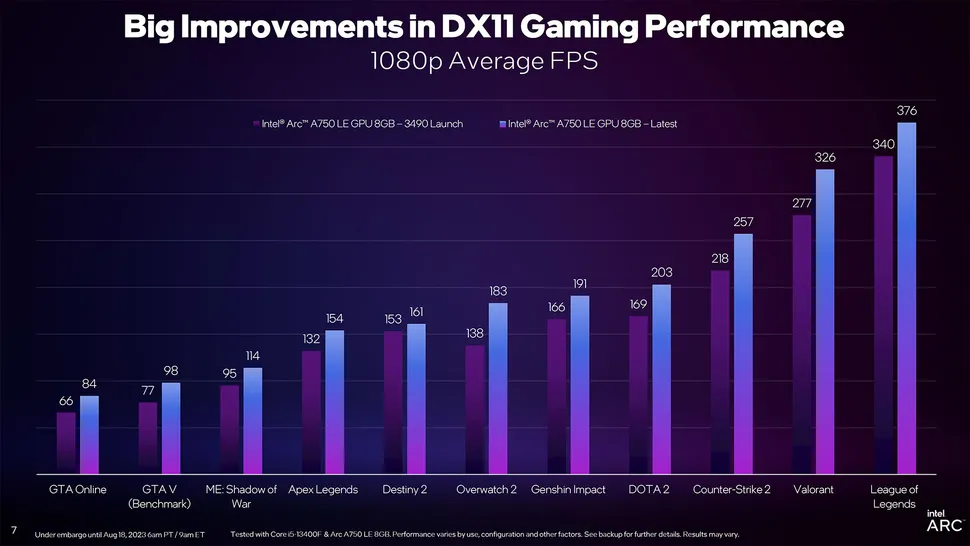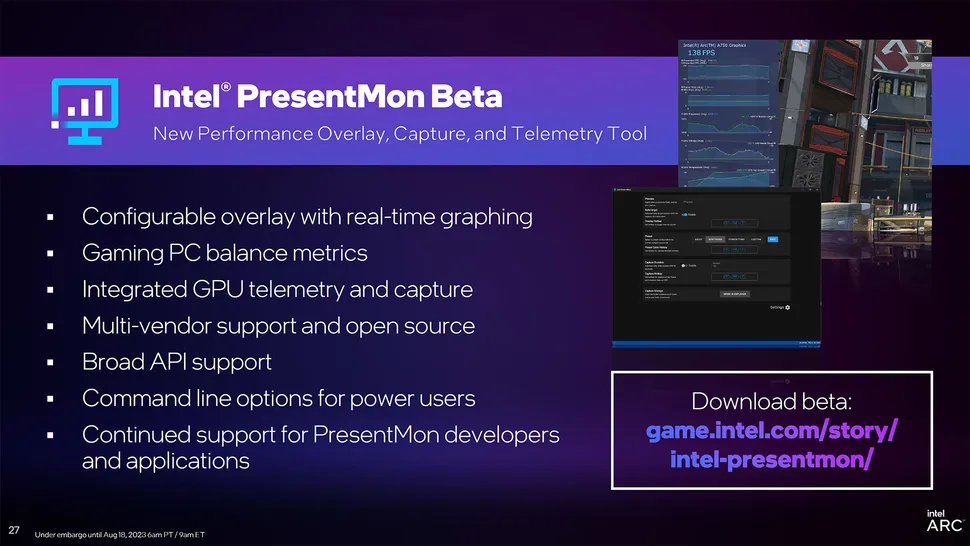Since its introduction roughly a year ago, Intel Arc Alchemist GPUs have become competitive graphics cards. Both excellent and bad drivers have been a recurring topic with Arc, but Intel has made progress to make things better and close the performance difference. To that purpose, Intel has made new drivers available that are designed to boost DirectX 11 performance.
The advantages are currently restricted to particular titles, according to Intel, who we spoke with earlier this week. To give some context, Intel discovered that several of the base driver components for its discrete and integrated GPUs were not optimum for Arc after the first launch of the technology. You can very much always assume that the GPU is the bottleneck when using integrated graphics. Anything that could be done to reroute work to the CPU in order to clear the backlog was considered a “good thing.” Of course, when the GPU becomes 10 times faster, as in the case of the Arc A770, the same rationale doesn’t necessarily apply any longer.
Therefore, Intel has put a lot of time and effort into updating the drivers since the product’s launch. This first became apparent in early 2023, when Intel boasted improvements in DirectX 9 performance. Microsoft’s DX9 on DX12 tools were used in the original Arc drivers to enable compatibility and get things up and running. But there was still a lot more performance left to be had. The Intel driver team reportedly worked with the open source DirectX on Vulkan project to further optimize the various components, something it was unable to achieve using the closed-source Microsoft tool. Things eventually got to the point where the new DXVK-optimized approach was being used for all (or most?) DX9 support.
Now, DirectX 11 games are receiving a similar treatment. However, Intel has tried to provide a unique code route for DX11 compatibility into its drivers, not in the same way as DXVK. The emphasis has been on evaluating particular games and then “whitelisting” them in the drivers to use the new code path because the existing DX11 support already functions, even though performance isn’t optimal. Apex Legends, Counter-Strike 2, Destiny 2, DOTA 2, Genshin Impact, GTA Online / GTA V, League of Legends, Middle-Earth: Shadow of War, Overwatch 2, and Valorant are among the 10 well-known DX11 titles that Intel now supports.
The most recent drivers essentially improve how the graphics hardware communicates with the DX11 API. Intel enhanced overall performance on DirectX 11 games by fine-tuning a number of factors and developing more effective rendering algorithms (it didn’t go into any low-level details). Here are the findings from its internal performance testing, which contrasts the most recent drivers (internal versions 4571 and 4642, albeit version 4644 drivers have since been released) with the first launch drivers (3490).

The new DX11 code route improved performance across all ten games (eleven if you add GTA Online and GTA V as distinct entries) by somewhere between 5% and 33%. The fact that Intel deliberately aimed the driver optimizations at “mainstream” CPUs — it tested with a Core i5-13400F and an Arc A750 — is what makes this development particularly intriguing.
The advantages on a top-end Core i9-13900K weren’t as noticeable, Intel states in later slides. When compared to the Core i5 CPU, performance improved by only 0% to 28% across the games that were chosen, with an overall average improvement of 12%.
This makes a lot of sense for future Arc A750 buyers, therefore we commend Intel for their testing and efforts in this area. Arc A750 cards are currently starting at $199, making them a fantastic value with performance that is comparable to the RTX 3060 and RX 6700 10GB. While supplies last on the 3060, both of those continue to sell for around $270, so the A750 offers excellent value. While we may base all of our testing on the Core i9-13900K CPU to minimize other bottlenecks, customers constructing a PC with an A750 are unlikely to spend much more than $200 for the CPU, which is where the i5-13400F sits.

Other intriguing news and bullet points from Intel were available for discussion. The most significant is an update to PresentMon, which serves as the basis for Nvidia FrameView, AMD OCAT, and CapFrameX. For the purpose of collecting frametimes and other metrics pertaining to graphics performance, Intel developed PresentMon as an open-source performance monitoring tool. Over the years, it has undergone numerous improvements, and now Intel is joining AMD and Nvidia in providing a more durable alternative.
With the addition of a GUI, the new PresentMon beta is far more user-friendly than the previous iteration. A variety of new features, including a strong overlay, histograms, and others, have also been added by Intel. A new “GPU Busy” measure is also available, which displays how much time was spent waiting on the GPU as opposed to the rest of the system. The new drivers’ main goal has been to minimize this discrepancy.
Future drivers will include the additional titles that Intel is still evaluating with the new DX11 code path. The new code may eventually be deemed reliable enough that Intel will simply flick a switch to force all games to use it; alternatively, there may be a blacklist where games with known bugs can remain on the older code.


[…] advantages, and migration resources associated with App Service Environment v3 by visiting the upgrade landing page for App Service Environment v3. This page is your one-stop […]